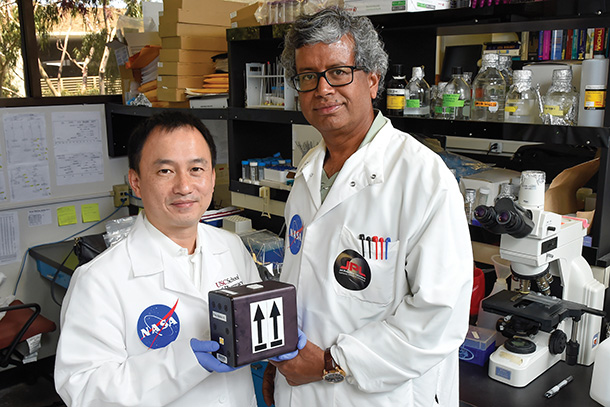Researchers at USC and NASA’s Jet Propulsion Laboratory say they will be the first team in the world to launch fungi into space for the purpose of potentially developing new medicine for use both in space and on Earth.
USC and JPL researchers are scheduled to send specimens of the Aspergillus nidulans fungus to the International Space Station aboard the SpaceX CRS-8 mission April 8.
The stressful environment of the International Space Station (ISS) could trigger changes in physiological responses (such as gene expression) and metabolism of Aspergillus nidulans, said Clay Wang, PhD, a professor of pharmacology and pharmaceutical sciences and chemistry at the USC School of Pharmacy and the USC Dornsife College of Letters, Arts and Sciences.
Certain types of fungi produce very important molecules called secondary metabolites that are not essential for their growth or reproduction but can be used to make beneficial pharmaceuticals, such as the antibiotic penicillin and the cholesterol-lowering drug lovastatin.
“The high-radiation, microgravity environment in space could prompt Aspergillus nidulans to produce molecules it doesn’t create in Earth’s less stressful conditions,” said Wang, who heads the USC-JPL collaborative study. “We’ve done extensive genetic analysis of this fungus and found that it could potentially produce 40 different types of drugs. The organism is known to produce osteoporosis drugs, which is very important from an astronaut’s perspective because we know that in space travel, astronauts experience bone loss.”
Based on current, Earth-based research, USC scientists said molecules from Aspergillus nidulans have the potential to be used in anti-cancer, anti-fungal and Alzheimer’s disease studies. As a leading research university, USC is uniquely equipped to address these intractable problems both on Earth and perhaps beyond.
A Falcon 9 rocket is scheduled to launch from Cape Canaveral Air Force Station in Florida at 1:43 p.m. PDT on April 8. This will be SpaceX’s first Cargo Resupply Services flight since CRS-7 exploded 139 seconds into flight on June 28, 2015.
Kasthuri “Venkat” Venkateswaran, senior research scientist at JPL and co-principal investigator in this study, said the new compounds that might be produced in space could be valuable for humankind.
“This is the first project where we see an intersection between pharmaceutical science and space exploration,” Wang said. “Drugs have an expiration date. NASA’s human mission to Mars is expected to last anywhere from one to three years. Not all drugs are going to be stable in that time period, so the ability to make drugs in space will enable us to go further away from Earth and will also benefit future space explorations.”
– Zen Vuong


